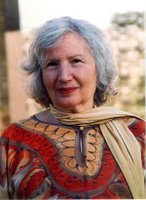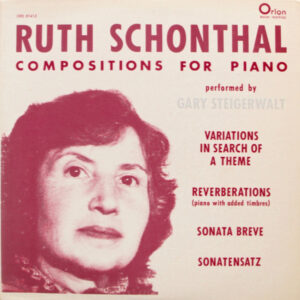This week will be celebrating the life and achievements of composer Ruth Schönthal, in honor or her centennial birthday! While there are many important recordings of chamber and solo works by Schönthal, We have been unable to find any readily sharable recording of her music for large ensemble. Please help us out if you can find any that we have missed! info@wophil.org 
Ruth Schönthal (June 27, 1924 – July 10, 2006) was born Ruth Esther Hadassah Schönthal in Hamburg, Germany, but lived much of her life in the United States. Most of her study and early career were spent in exile, and this had a distinct influence on the style and character of her music. Her family was Viennese-Jewish, and the changes to German society under increasing authoritarian rule leading to the Second World War meant that at age nine she was expelled from the Sternsches Konservatorium in Berlin. She had been the youngest student ever accepted, but by 1935 they forbade Jewish students (Helmig, 9, sources listed below). Her family emigrated to Sweden where she studied at the Swedish Royal Academy of Music in Stockholm (1938 to 1941), and during the war they fled to Mexico, traveling through the USSR to avoid the European conflict and settled in Mexico City. In 1946 she gave a performance of her Piano Concerto (1942), which happened to catch Paul Hindemith’s attention. He recommended her for a place at Yale, where she studied with him, graduating with honors in 1948.
As Catherine Parsons Smith describes, “Like others of his students, Schönthal struggled to establish her creative independence from Hindemith” after leaving Yale. Spending her formative musical years and training with many different teachers and institutions certainly afforded her a cosmopolitan musical language—she studied with Ingemar Liljefors in Stockholm, Rodolfo Halffter and Manuel Ponce in Mexico City, and Hindemith in the United States. Because she was writing music and performing to support her family, she had significant influence from popular music. Some of her first work was playing piano in bars, writing TV jingles, and songs for advertising. (Smith)
The late 1970s to the mid–90s were a particularly prolific period in which she produced some of her largest and most famous orchestral works. Her three operas are The Courtship of Camilla (1979–80) setting the unaltered one-act play by AA Milne that most readers know as The Ugly Duckling; Princess Maleen (1988), a classic German fairy tale by the Brothers Grimm; and Jocasta (1996–7), setting Hélène Cixous’ feminist play The Name of Oedipus. She also composed a second Piano Concerto (1977), and three tone poems: The Beautiful Day of Aranjuez for harp and string orchestra (1981, revised 1983), Evening Music (Nocturnal Fantasy with Ocean Waves) for orchestra (1992), and Soundtrack for a Dark Street for orchestra and electric guitar (1994).
As is not unusual with opera, Schönthal’s approach to characterization and philosophical ideas about music come through most strongly in her operatic works. Jocasta is particularly striking because in addition to being a feminist re-telling of the classic Oedipus story, the main characters, Jocasta and Oedipus, are represented by three different performers—an actor, a singer, and a dancer. Such casting of theses characters allowed Schönthal to highlight expressive links between these arts in her storytelling and setting of Cixous’ original play.
Schönthal worked as an educator, maintaining a private piano studio as well as teaching composition and music theory at NYU, a position she maintained until shortly before her death. Many of her piano students have achieved great success – including Stephanie Germanotta, who is more commonly known as Lady Gaga.

Cover for 1981 LP, Ruth Schonthal, Piano works performed by Gary Steigerwalt
There are quite a few recordings of her chamber and solo works and songs – which are also still readily published and available. Several of her piano works are available through Carl Fischer, and songs through the Southern Music Company. We can only hope that her larger works, including her Second Piano Concerto, The Beautiful Days of Aranjuez, Music for Horn and Chamber Ensemble, and many additional works available through her main publisher Furore Verlag, will once begin to get the attention they deserve on concert stages in the United States and abroad.
Furore Verlag offers this page which lists the events celebrating her centennial, including radio broadcasts, and a daylong symposium (which will stream) with performances on June 27. The full program for the symposium (held at the Hochschule is here (PDF).
Schönthal passed away in 2006 at age 82. The New York Times noted her many achievements as a composer and educator in her obituary. Learn more about the composer through her own voice in an extensive interview of Schönthal by Bruce Duffie here.
Listen in to some of her works through our Spotify Playlist below:
Sources:
Helmig, Martina. Ruth Schönthal: A Composer’s Musical Development in Exile. Lewiston: Edwin Mellon Press, 2006. English translation and updated version of book originally in German. Snippets on Google Books.
Smith, Catherine Parsons. “Schönthal, Ruth.” Grove Music Online. Oxford Music Online. Oxford University Press. Accessed 21 June 2024.
http://www.oxfordmusiconline.com/subscriber/article/grove/music/47049
Wikipedia Article: https://en.wikipedia.org/wiki/Ruth_Sch%C3%B6nthal
Furore Verlag, on Ruth Schönthal’s Centennial
Obituary in the New York Times
Biography by Neil W. Levin in the Milken Archive
Schonthal, Ruth. 1998. Interview by Neil W. Levin. Milken Archive Oral History Project. 31 March.
In Memoriam Ruth Schonthal. July 13, 2006. On An Overgrown Path (Blog)
Ruth Schonthal (1924-2006), A Remembrance — by Lowell Lieberman, who as a 14-year-old studied piano and composition with her
